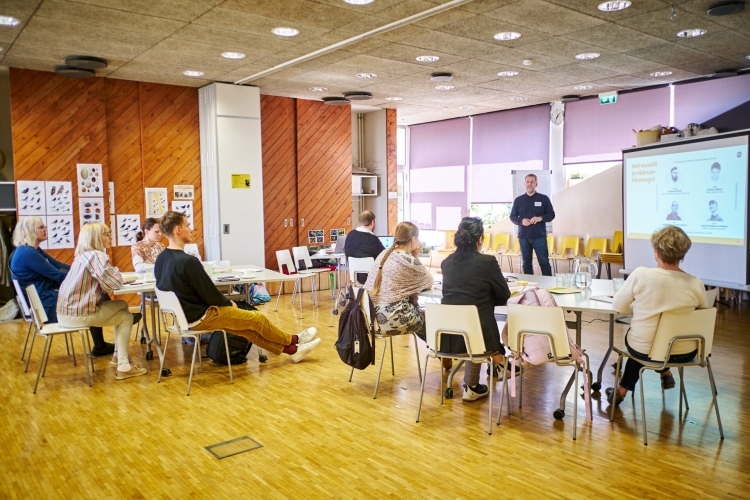Before we think about the planet, we tend to think about our wallets – mainly how big they are and how much we can save. Savings are exactly what the Lifestyle Test focuses on.
“Almost 70 per cent of climate emissions are linked to people’s daily lives – the way we eat, live, move and consume. The test shows where these emissions are coming from and give tips on how to reduce them,” explains Antti Lehtinen, the Head of Communications & Public Affairs of the Finnish Innovation Fund Sitra. He adds that the Lifestyle Test online app was created specifically to help people reduce their environmental impact and live more sustainable and healthy lives.
“We need a lifestyle test aimed at sustainability for the same reason why it makes sense to have regular health checks,” says Jannus Jaska, PSLifestyle Project Coordinator and Co-Founder of Green Tiger.
He adds that looking at how painfully the topic of sustainability is covered in society, we seem to be living under the illusion that Estonia is still an Eastern bloc country and that our European uncles shouldn’t bully us because we’re so poor. In fact, on a number of consumption indicators, we’ve become a leading consumer society, with world-class performance in wasting food, energy and other resources.
“This is an objective fact that needs to be acknowledged, and something must be done in the interests of sustainability,” explains Jaska. “We should consider the BMI an cholesterol levels when we plan health behaviour, not the opinion of our maters in the cigar club.” He believes that, on a personal level, understanding environmental impacts provides a foundation for a societal debate on what can be improved by the state, local authorities and business.
The questionnaire was developed in an EU-funded project called PSLifestyle. Citizens from eight European countries (Estonia, Finland, Germany, Greece, Italy, Portugal, Slovenia and Turkey) have participated. The test is based on an earlier version developed by Sitra, which has been taken more than 1.4 million times in Finland since 2017.
Lehtinen adds that the test can help save money, time and bring health benefits. “For example, lowering the room temperature or borrowing things instead of buying them are smart everyday choices that save money immediately. I recommend walking more, that is deliberately adding more physical activity to your daily routine, as it has proven health benefits. Studies have also shown that extending environmentally friendly behaviour can increase satisfaction with life,” lists Lehtinen.
Take the test and see how frugal you are
The app invites users to take a test to determine the impact of their lifestyle on the climate. Based on the results, users get tailored recommendations to change their lives. They can then prepare a plan that helps them see the impact of their daily activities. But this does not mean that stopping the climate crisis is the sole responsibility of individuals – raising awareness will help us as a society to choose a better direction. The responses and choices of individuals will also be collected into an anonymous dataset to help researchers and policymakers accelerate change across society.

Jannus Jaska says that we need a lifestyle test aimed at sustainability for the same reason why it makes sense to have regular health checks. Photo: private collection
Three years of work to help bring the tool to Estonia
According to Jannus Jaska, Coordinator of the PSLifestyle project and Co-Founder of Green Tiger, the lifestyle test arrived in Estonia due to very practical considerations. “When we were setting up the Green Tiger Foundation in 2019, in the wake of the European green transition, we were looking for scientific points of reference on how to define a balanced economy,” explains Jaska. “Conversations showed us that most of the stakeholders interested in sustainability had their own vision of how and where society should turn in order to seem green or sustainable enough.”
However, there was no evidence-based scale or real metrics for assessing sustainability in the discussions. By a happy coincidence, Jaska was invited in 2020 to work in the same Sitra team where the Finnish test was created and it quickly became clear that such a tool could be of great help in starting a positive and inclusive discussion on sustainability in Estonian society.
So, for the last three years, Jaska has worked on ensuring that such an evidence-based tool exists in Estonia. This was made possible with funding from the Horizon Research and Innovation programme of the European Union. “Soon, in the second week of November, our team wants to bring it to the wider public at the greentech exhibition NEXPO Tallinn,” he adds.
Four-part test helps improve life
The test is tailored for each country and the tips are not the same everywhere. The number of tips depends on the user’s answers. “The Finnish version selects tips from among 96 smart actions,” Lehtinen specifies.
Eluviisitest.ee consists of four parts: test, recommendations, action plan and feedback.
First, the user takes a test to see their carbon footprint. “Based on the results, the test will give tips on how to reduce the carbon footprint,” explains Lehtinen. “Users can also filter the tips to find advice on saving money or time, or learning new skills.”
There are plans to develop the test further in the coming years to provide better recommendations and community support. In early 2024, background information on biodiversity will also be added to the recommendations. This goal of this is to provide even more detailed answers. “As more users sign up, we plan to publish more in-depth statistics on the biggest areas of influence for people in Estonia and what are considered to be the main challenges,” says Jaska.
It is also important to know that the carbon footprint calculation is based on local data and is specific to each country. The tips are also tailored to the local conditions and habits of each country. “In Finland, for example, the test going to sauna less often – in countries where there are fewer or no saunas, this would not help,” says Lehtinen.
Although the Estonian eluviisitest.ee has so far been in a closed testing phase, a little over 1,100 test results have been collected since spring this year. According to the test, the average carbon footprint of Estonian users in carbon equivalents is 10,303 kg – Finland’s indicator, however, is 9,610 kg and there are almost 39,000. “Estonia has the biggest footprint among the eight countries in the categories of transport and shopping habits,” says Jaska. “I look forward to seeing how these numbers change when we reach a wider audience.”
It’s too early to draw any far-reaching conclusions yet, says Lehtinen, as the test has only recently been made public and has been taken around 50,000 times so far. He still hopes that the test can help European citizens to change their lifestyles and adopt more sustainable behaviour. The fact that the feedback to the test has been very positive so far is encouraging.
“Work on the Lifestyletest.eu is ongoing, especially with regard to the recommendations – all feedback and ideas for improvements and cooperation are welcome,” emphasises Jaska.

The working group played an important role in creating the test. Photo: Jannus Jaska/private collection
What recommendations does the test make?
The test takes around five minutes to complete and the results will provide recommendations tailored to your specific ethos to help reduce your carbon footprint, improve your quality of life and save you money. Here are a number of suggestions that could be suitable for many.
Reduce the use and temperature of electric saunas
The annual consumption of an electric sauna for one family is about 1,000 kilowatt-hours. This accounts for more than a tenth of annual electricity consumption. It is best to heat a sauna to 70-80 degrees. In a 100-degree sauna, electricity consumption is 20-30% higher.
Collect waste separately
Separate collection of waste is easy, smart and sustainable. At best it can even be fun, but at least it’s rewarding because you’re doing something real to help the environment. You may not know where to take the waste, but fortunately this information is readily available. See for example kuhuviia.ee.
Keep fridges and freezers tidy and clean
A messy fridge and freezer does more than just spread bad smells. Not dusting behind and inside the cold chamber can increase electricity consumption by up to 30%. There must be no dust around these household appliances and unobstructed air circulation must be ensured. Clean and well-maintained fridges last longer and reduce your electricity bills.
Buy discounted foods approaching their ‘best before’ date
As the ‘best before’ date approaches, stores sell perfectly good foods at large discounts, but many of them still end up in the bin. By saving these products, you avoid wastage, save money and can try different foods and new recipes.
Use your own shopping bags
Using your own shopping bag is an easy way to reduce single-use plastic waste. Reusable bags come in a variety of sizes and styles, so using them is not only a way to save money, it’s also a way to show your fashion sense!

